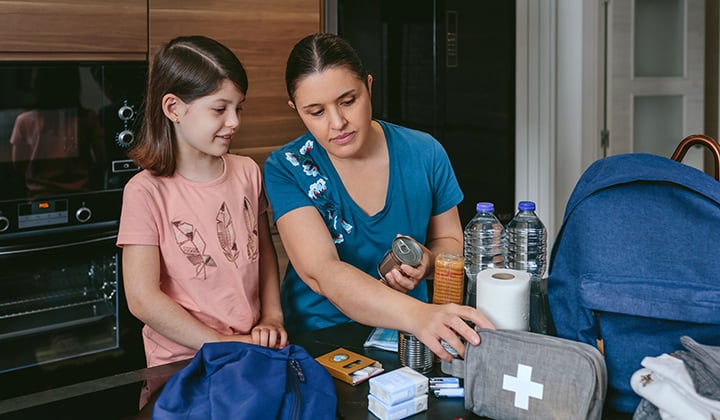Get updates
Have a parenting hack to share? Or a topic you'd like to see?
Emergency preparedness tips every family should know

Most parents don’t want to consider worst case scenarios. Thinking of your family encountering a natural disaster, fire or the like is scary, but a little preparation can ease worries and help make sure your family is ready to react quickly in a scary situation.
Keep reading for tips on which emergencies families should prepare for, how to build an emergency kit, ways to talk to your kids and more.
What are some examples of emergencies families should prepare for, and how can they do so?
- Power outages. In this situation, you want to have back-up lighting like flashlights, candles or glow sticks. Also make sure you have back-up power sources for any equipment that's needed, like medication that needs to be refrigerated or medical devices that rely on electricity. Have plenty of nonperishable food and bottled water on hand. A refrigerator will keep food cold for about 4 hours, and a freezer for 48 hours.
- Inclement weather. In the event of a tornado or severe storm, make sure you monitor weather reports and know how to get weather updates and alerts-especially if you lose electricity. Identify and practice going to a safe shelter location, whether it’s a storm shelter or small, interior windowless room or basement. Have a “grab bag” ready in the event of an evacuation, including things like emergency supplies, nonperishable food/water, medication, etc. In the event of extreme heat or cold, dress appropriately and know where the nearest cooling/warming centers are located. It's also helpful to know the signs of hypothermia and heat stroke, so you know when to seek care.
- House fires. Create and practice your family’s fire escape plan. Find 2 ways out of each room and make sure windows and screens are easily moved. You should also practice feeling your way out of the house in the dark with eyes closed. Replace all smoke alarm batteries twice a year, and make sure smoke alarms are installed on every level of your home, including the basement.
Overall, it’s key to make sure your family has an evacuation plan and that the whole family is aware of the plan. Know where you will evacuate to, and what you’ll take if you must leave in a hurry. Also remember to think of pets in every situation.
What are the basics to include in an emergency kit?
There are a few categories of items you want to make sure you have up to date and usable in case of an emergency:
- Important documents: photo IDs, birth certificates, current photos, insurance cards, etc.
- Basics: first aid kit, flashlight, cash, cell phone charger, etc.
- Clothing: weather appropriate clothing for each family member, work gloves, blankets
- Pets: food, vet records, carrier or crate
To see a full list of items for your emergency kit, click here.
Being prepared is an ongoing effort and true preparedness takes time. Every family is different and access to resources varies, so each item may not be accessible to each family. It is also important to discuss and practice your emergency plan and not prepare by simply checking things off on paper.
What are the steps of setting up a family emergency plan, and how often should families practice?
Before an emergency happens, have a family discussion to determine your points of contact and where you’d meet away from home. You can use this toolkit as a guide for your family’s plan. Involve your children in the planning and review it often.
Emergency plans should be reviewed twice a year and during times when hazards might be more likely, like heading into summer or winter or back to school times.
How can you talk to your children about emergencies in a way that makes them feel prepared, not scared?
Prepare with Pedro is a free disaster preparedness activity book for children. It educates children and their families on how to stay safe during disasters and emergencies through fun activities such as crosswords, coloring pages and matching games.
Discussing the possibility of an emergency helps children be prepared and practice can help them feel less anxious in a real event. Involving your child in assembling an emergency kit/plan and explaining each item’s purpose and the child’s role will provide them comfort and confidence to act in a real emergency.
Additional resources:
- Ready Kids
- Back to School emergency preparedness guide
- Family Emergency Preparedness: A Parent's Guide to Peace of Mind
